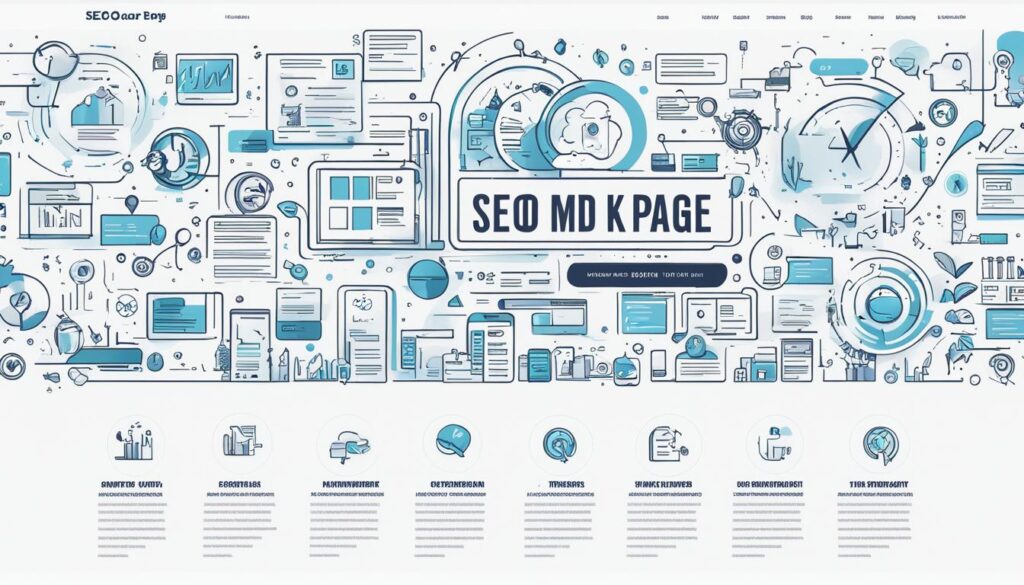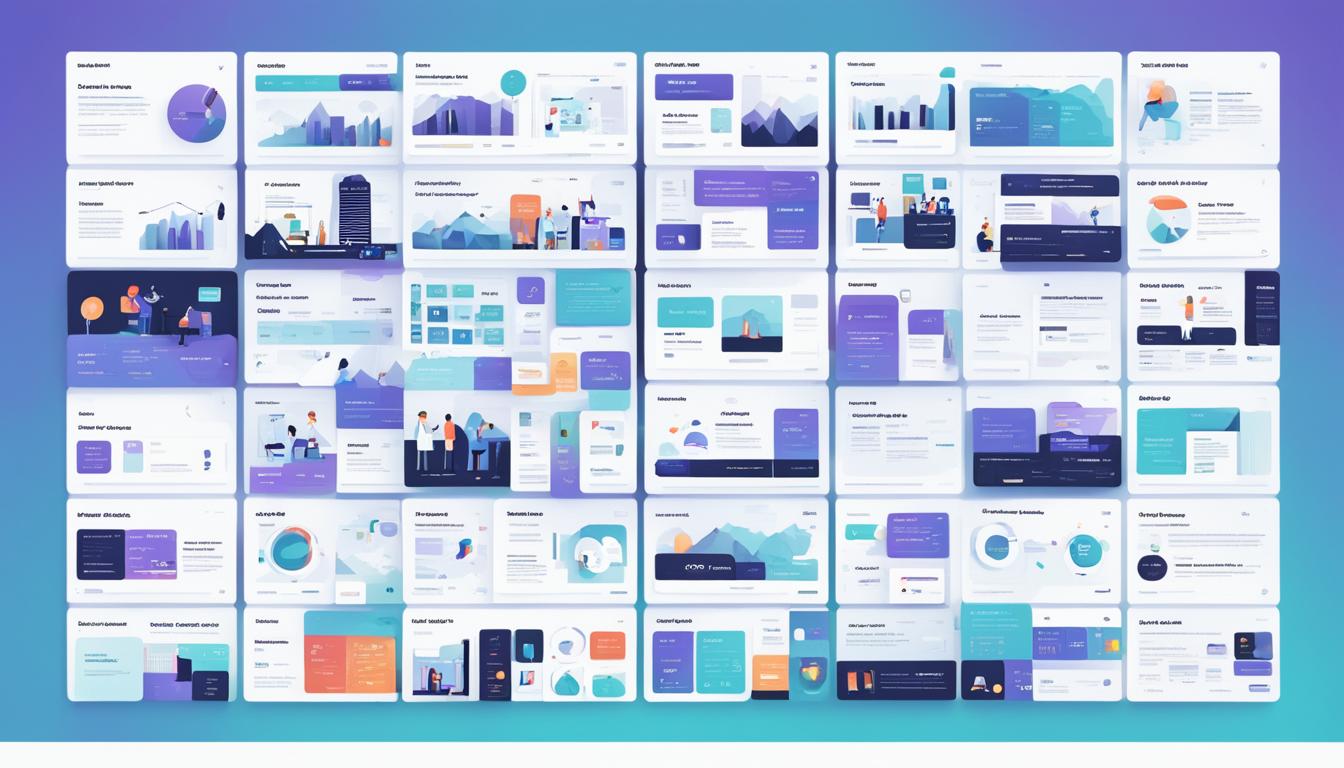When it comes to SEO writing, one size does not fit all. Each platform requires a unique approach to effectively optimize your content and captivate your audience. Whether you’re writing for a website, a blog, social media, landing pages, or email newsletters, understanding the nuances of platform-specific SEO is essential to succeed in the digital landscape.
In this article, I will share valuable insights and actionable tips on how to write SEO-friendly content for different platforms. By mastering these techniques, you’ll be able to maximize your visibility, engage your target audience, and drive organic traffic to your online presence.
Let’s dive into the world of platform-specific SEO writing and elevate your content creation game!
Key Takeaways:
- Adapt your writing style, tone, format, and keywords based on the platform you’re publishing on.
- Craft compelling blog posts with catchy titles, engaging introductions, and clear calls to action.
- Optimize your social media content by using relevant keywords, captivating captions, and multimedia elements.
- Create effective landing pages with persuasive headlines, concise body copy, and strategic keyword usage.
- Write SEO-friendly email newsletters using catchy subject lines, personalized greetings, and clear calls to action.
Writing Effective Blog Posts
When it comes to writing SEO blog posts, there are some best practices that are crucial for success. Following these guidelines will help optimize your content for search engines and engage your audience effectively.
- Create a Relevant and Catchy Title: Start your blog post with a title that is both relevant to your content and includes your main keyword. This will help drive traffic and improve your search engine rankings.
- Craft an Introduction: The introduction of your blog post should explain the purpose and benefits of the post. Incorporate your main keyword naturally to optimize it for search engines.
- Use Subheadings, Paragraphs, and Bullet Points: Break up your content to enhance readability. Use subheadings, paragraphs, and bullet points to organize information and make it easier for readers to scan and understand your post.
- Utilize Keywords Naturally: Incorporate your target keywords and related terms throughout your blog post. However, avoid keyword stuffing. Use them in a way that sounds natural and enhances the overall quality of your content.
- Include Internal and External Links: Linking to authoritative sources both within your website and externally can boost your SEO. Internal links help search engines understand your site’s structure, while external links add credibility to your content.
- End with a Clear Call to Action: Wrap up your blog post with a strong call to action that encourages reader engagement. This can include inviting readers to leave comments, share the post on social media, or subscribe to your newsletter.
By following these tips, you can create effective blog posts that not only rank well on search engines but also engage and resonate with your target audience. Remember to optimize your content for SEO, provide valuable information, and encourage interaction with your readers.
Optimizing Social Media Content

When it comes to SEO writing, social media platforms require a different approach. To maximize your online presence and engagement, here are some key strategies for optimizing your social media content:
1. Optimize Your Profile and Bio
Make sure to include relevant keywords and links in your social media profile and bio. This will help improve your visibility and attract your target audience.
2. Craft Concise and Catchy Captions
When writing social media captions, keep them concise and engaging. Incorporate keywords and calls to action to encourage interaction with your audience. A captivating caption can go a long way in capturing attention and driving engagement.
3. Use Relevant Hashtags
Hashtags are essential for increasing the discoverability of your social media posts. Research and use appropriate and relevant hashtags that are popular among your target audience. This will make it easier for users to find your content.
4. Incorporate Multimedia Content
A picture is worth a thousand words, and videos can convey even more. Enhance your social media posts by incorporating relevant images, videos, and other multimedia content. This not only makes your posts visually appealing but also helps you stand out from the crowd.
| Social Media Platform | Recommended Multimedia Content |
|---|---|
| YouTube | Videos, tutorials, vlogs |
| Images, videos, infographics |
5. Engage with Your Audience
Interacting with your audience is crucial for building a strong online presence. Like, comment, and share their posts to show your appreciation. Respond to comments and messages promptly to encourage engagement and establish meaningful connections.
6. Network with Others in Your Niche
Building visibility and expanding your reach on social media requires networking with others in your niche. Connect with influencers, industry experts, and like-minded individuals to increase your exposure and discover potential collaboration opportunities.
By following these optimization strategies, you can create SEO-friendly social media content that attracts your target audience, boosts engagement, and drives traffic to your website or business.
Crafting SEO Landing Pages

In order to convert visitors into leads or customers, landing pages play a crucial role in your SEO strategy. Here are some essential tips to optimize your landing pages:
- Landing Page Titles: Write unique and descriptive titles that include your main keyword and value proposition. This will instantly grab the attention of your target audience and make them curious about what you have to offer.
- Persuasive Headlines: Create compelling headlines that capture attention and entice visitors to explore further. Use persuasive language to highlight the benefits and solutions your landing page provides.
- Subheadlines: Use clear and compelling subheadlines to explain the key benefits of your product or service. These subheadlines should build on the curiosity generated by your headline and entice visitors to continue reading.
- Body Copy: Keep the body copy concise and compelling. Address the pain points of your target audience and build trust by showcasing the value and credibility of your offering. Use clear and concise language to effectively communicate your message.
- Keyword Usage: Incorporate keywords naturally throughout your landing page, but avoid keyword stuffing. Focus on providing valuable and informative content that resonates with your audience and meets their needs.
- Call to Action: Add a strong and clear call to action that encourages visitors to take the desired action, such as filling out a form, making a purchase, or contacting your business. Make the call to action prominent and visually appealing.
- Page Optimization: Optimize your landing page for page speed, layout, design, and mobile-friendliness. Ensure that your landing page loads quickly and looks visually appealing on various devices.
The success of your landing page depends on its ability to engage visitors and convince them to take action. By following these tips, you can craft highly optimized SEO landing pages that drive conversions and ultimately, business growth.
Writing SEO-Friendly Email Newsletters

Email newsletters are an effective way to communicate with your audience. To ensure maximum impact, it’s essential to optimize them for search engines and engage your readers. Here are some important tips to make your email newsletters SEO-friendly:
Craft Catchy Subject Lines
Subject lines are the first thing your subscribers see. Make them catchy and attention-grabbing by incorporating your main keyword. This increases the chances of your emails being opened and read.
Use Personalized Greetings
Start your email with a personalized greeting that addresses your subscribers by name. This creates a sense of connection and makes your readers feel valued.
Write Engaging Introductions
The introduction sets the tone for your email. Grab your readers’ attention and make them want to keep reading. Use storytelling techniques, ask questions, or provide teasers to create curiosity.
Deliver Clear and Informative Body Copy
The body copy of your email should be clear, concise, and informative. Use keywords naturally and avoid keyword stuffing. Provide valuable content to your readers and focus on delivering helpful information.
Include Links to Relevant Content or Offers
Include links in your email that direct readers to relevant content or special offers. This improves engagement and encourages subscribers to take action.
End with a Compelling Call to Action
Every email should have a clear call to action that prompts readers to take the desired action. Whether it’s clicking a link, making a purchase, or subscribing, clearly communicate what you want your readers to do.
Remember to optimize for readability, grammar, and spelling to ensure a professional and polished email. By following these tips, you can create SEO-friendly email newsletters that engage your audience, drive traffic to your website, and increase conversions.
Understanding Your Audience and Choosing the Right Platform
Before diving into the world of SEO writing, it’s crucial to have a deep understanding of your target audience and their preferences. By conducting thorough target audience research, you can gain insights into their needs, pain points, and communication style.
Utilizing tools like Google Analytics and social media insights can provide valuable data on audience demographics, behavior, and interests. This information will help you tailor your content to meet the expectations and desires of your audience.
Once you have a clear understanding of your target audience, it’s time to choose the right platform for your content. Different platforms have their own writing conventions and platform-specific guidelines that you need to follow.
Consider the message you want to convey and the goals you want to achieve. Does your content lend itself better to a blog, social media, email newsletters, or landing pages?
Each platform has its own strengths and weaknesses, so choose the one that aligns best with your content and goals. Whether it’s the long-form format of a blog, the visual appeal of social media, or the direct customer interaction of email newsletters, your platform choice can greatly impact the effectiveness of your SEO writing.
Remember, each platform has its own set of writing conventions and guidelines. Familiarize yourself with these guidelines to ensure your content is optimized for each platform. Use appropriate formatting, tone, and style to engage and connect with your audience effectively.
Ultimately, understanding your audience and selecting the right platform for your content will help you create targeted and engaging SEO content that resonates with your readers, drives traffic, and boosts your online visibility.
Strategic Use of Keywords and Simplified Writing

Keywords play a vital role in SEO writing. To effectively optimize your content, it is essential to conduct thorough keyword research. This will help you understand the terms and phrases your target audience uses when searching for information and what topics are popular in your niche.
Once you have identified relevant keywords, strategically incorporate them throughout your content. Use keywords naturally in titles, headings, introductions, body paragraphs, and conclusions. However, it is crucial to avoid overusing or stuffing them, as it can negatively impact readability and user experience.
When writing SEO content, focus on adopting a clear and simple language. Use short sentences and paragraphs to enhance readability and make your content more accessible to a wider audience. Utilize the active voice to make your writing more engaging and direct.
In addition to using appropriate language and voice, formatting is also important. Break your content into sections with descriptive headings to improve organization and navigation. Incorporate visual aids, such as images and diagrams, to enhance understanding and engagement.
Benefits of Strategic Keyword Usage and Simplified Writing:
- Improved search engine rankings
- Increased visibility and organic traffic
- Better user experience and engagement
- Clear communication of ideas and information
- Enhanced readability and accessibility
Strategic keyword usage and simplified writing are crucial elements of effective SEO content. By conducting thorough keyword research, incorporating keywords naturally, and adopting a clear and simple language, you can optimize your content to reach a wider audience and improve search engine rankings.
| Strategies for Strategic Keyword Usage and Simplified Writing | Benefits |
|---|---|
| Thorough keyword research | Improved targeting and relevance |
| Natural incorporation of keywords | Enhanced search engine visibility |
| Clear and simple language | Better understanding and engagement |
| Short sentences and paragraphs | Improved readability and accessibility |
| Utilization of active voice | Increased user connection and impact |
| Use of descriptive headings | Better content organization and navigation |
| Incorporation of visual aids | Enhanced comprehension and engagement |
By strategically using keywords and simplifying your writing, you can create SEO content that not only ranks well on search engines but also connects with your target audience. Remember to conduct keyword research, use keywords naturally, adopt clear language and formatting techniques, and provide visual aids to enhance the overall readability and effectiveness of your content.
Conclusion
Writing SEO content for different platforms requires a versatile approach. To optimize your content for diverse platforms and engage your audience effectively, it’s crucial to adapt your style, tone, and content to suit each platform’s requirements.
Understanding your target audience is key. Conduct thorough research to gain insights into their preferences, pain points, and communication preferences. Choose the platform that best aligns with your message and goals, and tailor your content accordingly.
Strategic use of keywords is essential for SEO writing. Conduct comprehensive keyword research to identify popular topics and terms used by your audience. Incorporate keywords naturally throughout your content, from titles and headings to introductions and conclusions. However, avoid overusing or stuffing keywords, as it can negatively affect readability and user experience.
Optimizing your content for diverse platforms also involves utilizing clear and engaging writing techniques. Use clear and simple language, active voice, and formatting to enhance readability. Incorporate visual aids, such as images or bullet points, to make your content more appealing and scannable.
Remember, your ultimate goal is to provide value to your readers while boosting your online presence. Continuously test, measure, and optimize your writing strategies to drive user engagement and improve visibility across diverse platforms.










